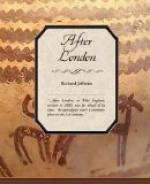The meadows, besides being divided by the hedges, kept purposely cropped low, were surrounded, like all the cultivated lands, by high and strong stockades. Half a mile down the South Road they left the track, and following a footpath some few hundred yards, came to the pool where Oliver had bathed that morning. The river, which ran through the enclosed grounds, was very shallow, for they were near its source in the hills, but just there it widened, and filled a depression fifty or sixty yards across, which was deep enough for swimming. Beyond the pool the stream curved and left the enclosure; the stockade, or at least an open work of poles, was continued across it. This work permitted the stream to flow freely, but was sufficiently close to exclude any one who might attempt to enter by creeping up the bed of the river.
They crossed the river just above the pool by some stepping-stones, large blocks rolled in for the purpose, and approached the stockade. It was formed of small but entire trees, young elms, firs, or very thick ash-poles, driven in a double row into the earth, the first or inner row side by side, the outer row filling the interstices, and the whole bound together at the bottom by split willow woven in and out. This interweaving extended only about three feet up, and was intended first to bind the structure together, and secondly to exclude small animals which might creep in between the stakes. The reason it was not carried all up was that it should not afford a footing to human thieves desirous of climbing over.
The smooth poles by themselves afforded no notch or foothold for a Bushman’s naked foot. They rose nine or ten feet above the willow, so that the total height of the palisade was about twelve feet, and the tops of the stakes were sharpened. The construction of such palisades required great labour, and could be carried out only by those who could command the services of numbers of men, so that a small proprietor was impossible, unless within the walls of a town. This particular stockade was by no means an extensive one, in comparison with the estates of more prominent nobles.
The enclosure immediately surrounding the Old House was of an irregular oval shape, perhaps a mile long, and not quite three-quarters of a mile wide, the house being situated towards the northern and higher end of the oval. The river crossed it, entering on the west and leaving on the eastern side. The enclosure was for the greater part meadow and pasture, for here the cattle were kept, which supplied the house with milk, cheese, and butter, while others intended for slaughter were driven in here for the last months of fattening.
The horses in actual use for riding, or for the waggons, were also turned out here temporarily. There were two pens and rickyards within it, one beside the river, one farther down. The South Road ran almost down the centre, passing both rickyards, and leaving the stockade at the southern end by a gate, called the barrier. At the northern extremity of the oval the palisade passed within three hundred yards of the house, and there was another barrier, to which the road led from the Maple Gate, which has been mentioned. From thence it went across the hills to the town of Ponze. Thus, anyone approaching the Old House had first to pass the barrier and get inside the palisade.




